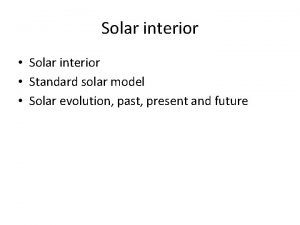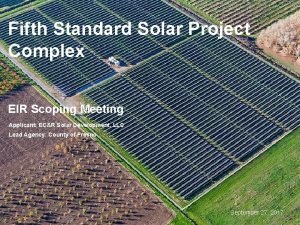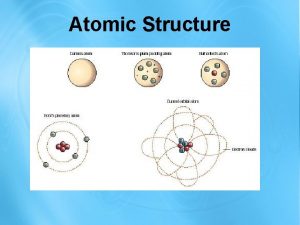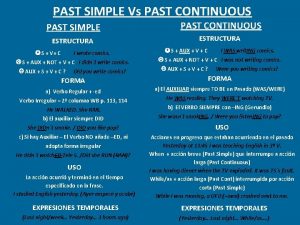Solar interior Standard solar model Solar evolution past





















- Slides: 21

Solar interior • Standard solar model • Solar evolution, past, present and future

The solar interior Solar interior cannot be directly observed, information is from: • Theoretical models • Helioseismology • Solar neutrinos Consists of the core, radiative zone, convection zone. The core produces energy, which is then transported radially outwards through the radiative zone (by radiation) and then through the convection zone (by convection).

Solar chemical composition Element Abundance Mass fraction H 0. 934042096 0. 76914905 He 0. 064619943 0. 21284852 O 0. 000759218 0. 00489926 C 0. 000371849 0. 00090196 N 0. 000091278 0. 00875263 Fe 0. 000039844 0. 00046787 Mg 0. 000035511 0. 00003996 Si 0. 000033141 0. 00004053 Al 0. 000002757 0. 00131240 Ca 0. 000002140 0. 00152403 Na 0. 000001997 0. 00006377 These are photospheric abundances. The photosphere is mostly composed of hydrogen (93. 4% of atoms). Some helium (6. 5%). Everything else is <0. 1%. But this “everything else” is important: • where do those elements come from? • also, they are widely used in solar spectropolarimetry Interestingly, the core has more helium than hydrogen. Since the energy is transported radiatively (not convectively) there, there is no mixing, so no core helium appears at the surface.

The core • Mass is turned into energy • Burn rate: 7 1011 kg/s (Apollo mission Saturn V first stage engine F-1 burned 2500 kg/s of kerosene+oxygen) • Temperature (particle velocity) and density (distance between particles) are high enough for protons (hydrogen ions) to overcome Coloumb barrier and ram into each other. • Most of the solar energy (99%) is coming from proton-proton chain (p-p chain) • 1% is from CNO cycle for present-day Sun (in hotter stars can be dominant source)

p-p chain

CNO cycle

Energy output • Both p-p and CNO chains are closed loops. • Both p-p and CNO chains produce Helium (αparticle), neutrinos, and γ-radiation. • Both p-p and CNO chains produce 26 Me. V per Helium nucleus in form of photons and neutrinos. • Photons are reabsorbed by gas, gas is heated. • Neutrinos escape.

p-p branches and energies Branching ratios: 1 vs 2 - 87/13, 2 vs 3 – 13/0. 015

CNO cycle energies Note: C, N and O act only as catalysts. Basically, the same thing happens here as in p-p chain!

Some stellar physics to remind • We know: M , L , R. • We also know that the Sun is in (more or less) equilibrium. • We have gas pressure, radiative pressure and gravity. We also have an energy source – the core. • We assume the Sun is non-rotating and spherically symmetric.

Equations of stellar (gas ball) structure Mass: (1) Mass continuity: (1) and (2) can be grouped into Lane. Emden equation: Equation of state: (2) Hydrostatic equilibrium: Total pressure, e. g. : Luminosity equation: Connects pressure, density, temperature, energy generation rate, chemical composition, opacity etc. Cannot be expressed as a single/simple equation. Simple approximations available: Polytrope, polytropic index n=1/(γ-1); analytical solutions exist for n=0, 1, 5 for Lane-Emden eqn. Ideal gas equation of state Include radiative pressure? (find if and where it is important for the Sun! What about other stars? ) Energy transport – next page. Although they give an idea of how a star behaves, they are crude approximations. Reality is much more complex! Normally, tabular equations of state for numerical integration etc.

Equations of stellar structure II Energy transport in radiative zone Photon mean free path: where σT is Thompson scattering constant, <Ne> is electron number density. The Sun is neutral, so <Ne> = <NP> - mean proton number density, which is equal Then, λ=0. 018 m. Time for a photon to travel this distance is λ/c=6 10 -11 s. Random walk: total number of walks for a photon to travel from the core to the surface is (R Sun/λ)2 = 1. 5 1021. The time for a photon to travel from the core to the surface is then 9 1010 s = 3000 years. Thermal equilibrium -> Planck function for intensity. Not going into details for a while (we could have some time later): we substitute Planck function into radiative transport equation, integrate it over angle and frequency, calculate opacities and introduce Rosseland opacity, after some tweaking to get the temperature gradient if the energy is transported by radiative diffusion:

Radiative zone and convective zone As the temperature decreases towards the solar surface, fully ionized gas begins to recombine: opacity κ increases, and plasma becomes less transparent. Thus gives stronger temperature gradient. Radiative transport becomes inefficient, convective transport gets into play.

Adiabatic convection Gas element ρ2’, p 2’, T 2’ Gas outside ρ2, p 2, T 2 To understand what is convection, we follow a gas element which rises adiabatically (does not exchange heat with surrounding gas). Now, if ρ2’<ρ2 (density within gas element is smaller than outside density), the gas element will keep rising. At the top, the gas element radiates/looses heat, cools and falls down. This is the convective cycle. ρ1’, p 1’, T 1’ ρ1, p 1, T 1 Evidence of convection: dynamic granulation at the solar surface.

Solar surface granulation

Convection If a gas element rises quickly compared to the time to absorb or emit radiation, it can be considered as adiabatic process, for which Here - ratio of specific heat capacities at constant pressure and volume. It is 5/3 for a fully ionized hydrogen. Same gas element: Bottom: Pressures equal at the top: Density at the top: Using we derive: and , and assuming P=P(r), T=T(r), ρ=ρ(r), Schwarzschild instability criterion Adiabatic temperature gradient Convection occurs when the actual temperature gradient is greater than adiabatic temperature gradient.

Brunt-Väisälä frequency ρ1, P 1, T 1 ρ2, P 2, T 2 ρ(r) g r ρ2’, P 2, T 2’ Imagine a parcel of gas with density ρ1 in vertically stratified (arbitrary, nonadiabatic) gas background with ρ(r), P(r), T(r), and ρ2<ρ1. A small adiabatic displacement r of the parcel upwards will lead to an extra gravitational force directed downwards and acting on the parcel: ρ1, P 1, T 1 - Harmonic oscillator equation Straightforward solution: Where oscillatory - Brunt-Väisälä frequency. unstable (exp growth) Show that N 2<0 is equivalent to Schwarzschild instability criterion! By the way, we’ve just discovered solar internal g-modes. Currently not observed, since hidden below convective zone and evanescent. Expected ~<1 mm/s solar surface velocity, very low frequency: one of the unsolved problems in solar physics…

But • Convection is complicated: complex interaction of non-linear flows, turbulence, which do not (currently? ) allow analytical solutions. Some clues are from mixing length theory, want better description…

Internal structure of the Sun Internal structures are shown for ZAMS (zeroage-main-sequence, young, subscript z) and present-day (subscript , reaching 1 solar radius) Sun.

Solar evolution (sad but true…) Evolution of the Sun: (a) Gravitational Contraction (b) Main Sequence (c) Red giant (d) He-burning stage (e) White dwarf

Solar plasma Convection is complicated Temperature is very high Completely or partially ionized gas -> Charges (protons and electrons) are present + Magnetic field is somehow generated and observed • Quite dense • -> Need a good description of ionized fluid (plasma), since solving ~1030 equations of motion for each charged particle is not realistic… • • •
 Standard solar model
Standard solar model Simple past and past progressive
Simple past and past progressive Ejemplos de simple past y past continuous
Ejemplos de simple past y past continuous Past perfect past continuous past simple exercise
Past perfect past continuous past simple exercise Past tense past continuous past perfect
Past tense past continuous past perfect презент прогрессив таблица
презент прогрессив таблица Narrative tenses past simple
Narrative tenses past simple Past continuous past simple
Past continuous past simple Write a story using past simple and past continuous
Write a story using past simple and past continuous Narrative tenses
Narrative tenses Simple past vs present perfect
Simple past vs present perfect Rumus standar error rata-rata
Rumus standar error rata-rata Standard language meaning
Standard language meaning What is standard cost
What is standard cost Bahagian pembangunan kurikulum dskp 2020
Bahagian pembangunan kurikulum dskp 2020 Fifth standard solar
Fifth standard solar Wholesale solar cell battery
Wholesale solar cell battery What is an inexhaustible source of energy
What is an inexhaustible source of energy Atomic model evolution
Atomic model evolution Channel evolution model
Channel evolution model Slow evolution
Slow evolution Multiple zone model
Multiple zone model






































